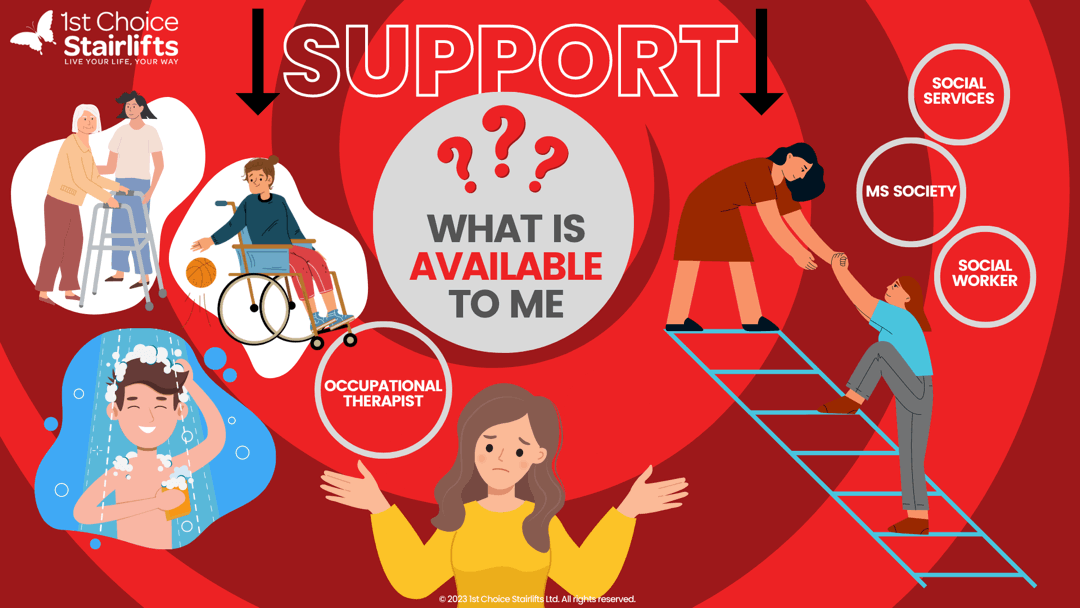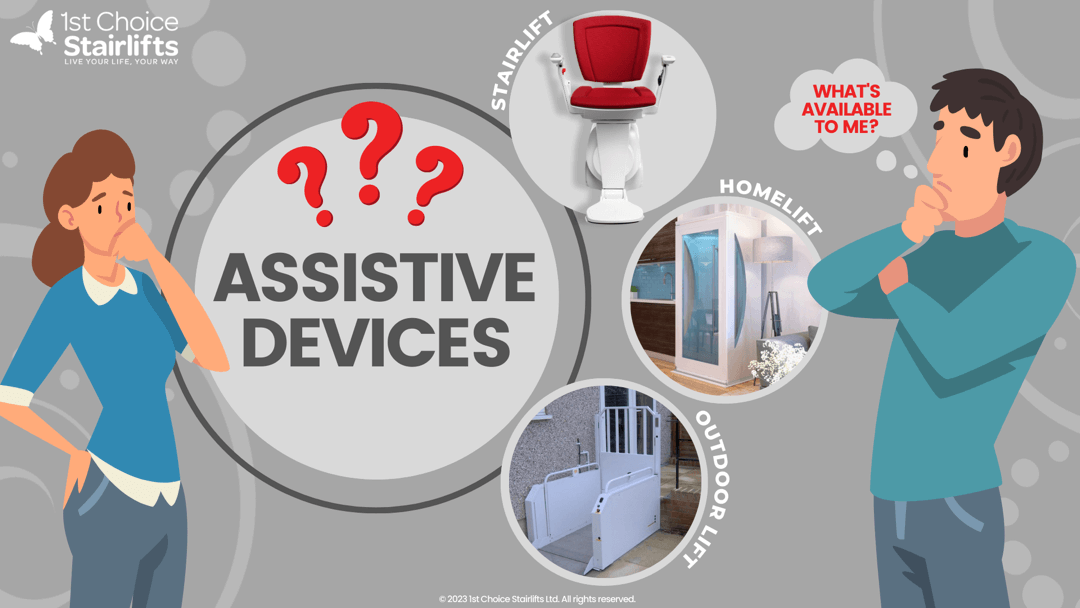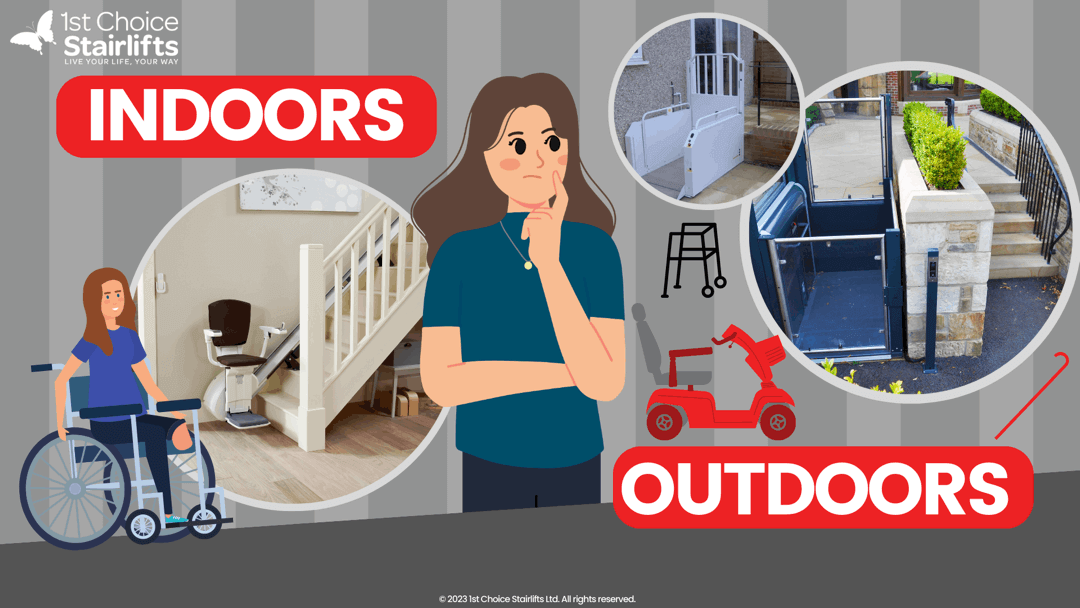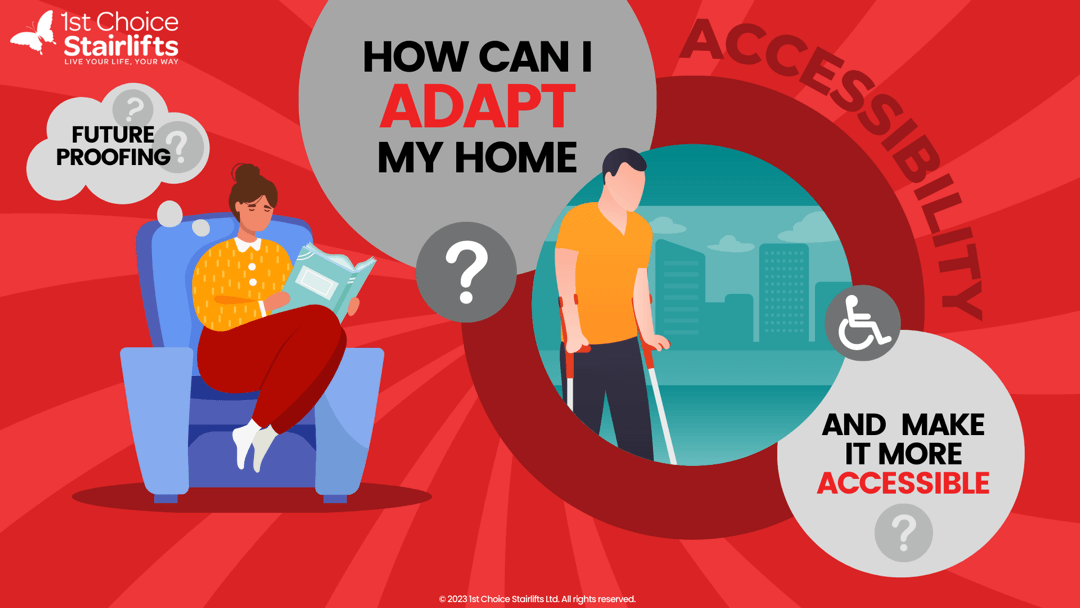If you’re worried about how you are going to be able to stay in your home if you have multiple sclerosis, we are here to help you find the best solution to overcoming the most challenging place in the home and that’s being able to navigate the stairs.
Table of contents
- What support is available for people with MS?
- What does an Occupational Therapist do?
- What assistive devices are available for people with MS?
- What about stairlifts for people with MS – are they a good idea?
- What support is available to make my workplace more accessible?
- How do I get a stair lift, home lift, or vertical lift?
There are many barriers to accessible living, but ones that can be easily solved with assistive technology and mobility equipment that can help your mobility and independence.
So if you are stuck on how to make the stairs easier to climb, here are our top tips.

What support is available for people with MS?
MS is a progressive lifelong condition that can affect your mobility in various ways. The symptoms of MS can come and go sporadically, or they can be progressive depending on the type of MS you have.
There is a lot of support and advice available from various resources including the MS Society and a social worker. When it comes to home adaptations and getting help your local Social Services can provide an occupational therapist referral.
What does an Occupational Therapist do?
An Occupational Therapist will “help people of all ages and abilities to overcome challenges completing everyday tasks or activities”. In other words, they will help you to make your life easier with focused activities or adaptations to help make everyday life easier. (source Royal College of Occupational Therapists). About occupational therapy
They may recommend assistive devices to help give you the tools to become more independent and live life well. Normally they will visit your home to provide information and advice and can recommend products from various companies that can help with your accessibility.

What assistive devices are available for people with MS?
There are so many pieces of equipment that can help make your life easier, but in this article, we are going to specifically cover assistive devices that help with stairs and barriers to access. Moving between the floors in your home can be a problem when your symptoms are worse. You could consider moving house but that could be very costly, and if you don’t want to leave the home that you love, then making adaptations is the key to having an accessible home.
Depending on your mobility, there are several solutions that you may want to consider from fitting grab bars or handrails to installing stairlifts, home lifts, or wheelchair lifts. You may also want to consider ramps for accessibility outdoors, which we also cover later on.
If you just need a little help to climb up the stairs, fitting a grab bar or extra handrail may be all you need. This is a relatively low-cost option and may even be done for free by your local social services.
What about stairlifts for people with MS – are they a good idea?
If you have MS and are having problems with stairs, at some point you may want to consider having a stair lift. When you are unable to negotiate the stairs safely and it poses a falls risk, a stair lift will make life easier and safer.
Many people think that stair lifts are for old people, but they are for people of all ages who find stair climbing difficult. It’s not your health condition that makes your house inaccessible it’s your stairs and the design of houses today!
Having a stair lift installed is an easy process and it can be completed in just a few hours. It operates simply with a joystick control and a car-style seatbelt that clips in to keep you safe in travel. It will connect to your mains power supply to power the lift. All you need to do is to be able to transfer on and off the stairlift seat safely.
When is a stairlift not suitable?
When you are unable to transfer on and off the stairlift seat yourself, you could consider being hoisted in and out of the stairlift seat with the aid of a carer. Carer remote controls come with a stairlift as standard if you can’t operate it independently yourself.
Previous examples we have installed include a stairlift and a hoisted transfer on and off the seat, with the lift parked away from the stairs for safer hoist transfer using a curved stairlift.
However, you might want to remain as independent as you can for as long as you can, and if you use a wheelchair or are likely to in the future, you may need to think about installing a vertical home lift.

Is a Homelift more suitable for wheelchairs?
Many people prefer to have a futureproofed solution and have a home lift fitted, where budget allows. The price of a stairlift is significantly cheaper than having a home lift fitted, but home lifts can make you more independent. We are Trusted Product Advisors and regularly work with and give training to Occupational Therapists on stair lifts and other equipment, so we will only recommend what we believe will be the best solution.
The home lift can be futureproofed to accommodate you if you are ambulant or need a wheelchair. If you are not a wheelchair user a fold-up seat is available inside the home lift car to sit in the lift whilst it takes you through the floor.
If you need the lift to take a wheelchair, the fold-up seat can be removed or simply folded up out of the way. The car size and the space it will take up will depend on the size of the wheelchair it needs to hold.

How do I make getting in and out of my home more accessible?
People with disabilities want accessibility throughout their homes, so what happens if there are changes in levels outside the house with steps outside?
You won’t want to be stuck inside your home, so how do you access outside to go out to hospital appointments, meet friends, go shopping, or even visit your workplace?
The good news is that there are even stair lifts for outside steps, for both straight and curved stairs. For wheelchair users, there are steplifts that rise vertically and incline platform lifts that can travel in line with the stairs.
And where the change in height is quite a shallow gradient, it may be possible to install ramps.
Who is eligible for a free stair lift or disability equipment?
Most people who get a stairlift or home lift have a permanent disabling health condition. In the UK you or your doctor can request an occupational therapist (OT) referral, who can assess you for equipment and adaptation. This can be self-funded or paid for through a means-tested disabled facilities grant (DFG).
When it comes to a stair lift or a home lift, you will need to bear in mind that you will be required to maintain the product.
In the UK some local authorities will cover maintenance and servicing and some don’t, so please do check the cost of maintenance and services to see if you can afford the ongoing costs if you qualify for a DFG. A stair lift would need to be serviced once a year and twice a year for other lifts.
The supply of disability equipment is normally VAT zero rating, which means you don’t get charged VAT on the cost of the equipment.
What support is available to make my workplace more accessible?
When it comes to office and other work environments, they can be made accessible with lifts too! We sell a wide range of lifts which you’ll see on our website that will benefit you and your company.
The Equalities Act, which incorporated the Disability Discrimination Act, asked businesses to make reasonable adjustments to environments. However “reasonable” can be interpreted in many ways!
Some businesses, like our company, believe in creating a space that has accessibility. For example, we have a vertical through-the-floor home lift installed in our showroom with automatic doors. Whenever someone can’t manage the stairs and they need to go upstairs, then they simply use the lift.
There are many commercially rated lifts, like small passenger lifts which are not nearly as complicated to install as a huge passenger lift.
The Equalities Act covers employees which could include volunteers too, but it also concerns customers as well! Shops, sports facilities, etc are all public buildings that need accessibility and models are available to fit into these environments.
As well as lifts of course ramps are very beneficial to overcome steps and changes in levels and we can help with these too.
How do I get a stair lift, home lift, or vertical lift?
1st Choice Stairlifts offer a range of the best quality stair lift and mobility equipment to help with home adaptations and make your home more accessible. We will only recommend the best product for your home and your needs. We’re here for a friendly chat to run through everything with you, all you need to do is phone us on 01249 814528.
You can check out our range of straight, curved, new and reconditioned stair lift models as well as home lifts, steplifts, and platform lifts. We offer a full range of aftercare too and look after you and your lift with services and maintenance too.
If you’re not sure what kind of equipment might be suitable, then come and visit our showroom in Calne to see the benefits they can bring. There you can see and try out our range of products and we’ll give you full training on how to work them but don’t worry, it’s really not that complicated!
We have level access throughout the showroom and an accessible bathroom. Parking is also right outside our doors to the showroom.
To book a no-obligation home survey to get a quote or to arrange a showroom appointment call our sales team on 01249 814528.
As a responsible company we only ever offer the best advice and are endorsed Which Trusted Traders. We are also members of the British Healthcare Trades Association who regulate conduct in the disability, mobility and assistive technology equipment industry through their Code of Practice which is approved by the Trading Standards Institute.









